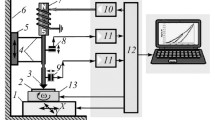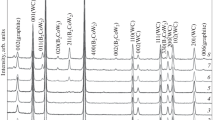Abstract
We have studied the properties of composites in the B4C-VB2-C system, obtained by reaction synthesis with hot pressing. We have established that the presence of free carbon and vanadium boride in the ceramic makes it possible to activate the sintering process and to obtain a dense, highly dispersed ceramic with good structural homogeneity parameters for lower isothermal holding temperatures. The composite ceramic has higher hardness and bending strength over a broad range of vanadium boride content than the monophase ceramic based on boron carbide. The strength properties of the composite ceramic containing up to 8 vol.% vanadium boride are improved by means of a mechanism involving propagating cracks bending around obstacles. When the VB2 concentration increases further, the properties of the composite are determined by a microcracking mechanism. In this case, we observe relatively small changes in the elastic characteristics, which depend linearly on the composition of the ceramic. Introducing vanadium boride into the material is also accompanied by an increase in the contact and microstructural strengths. The results obtained indicate that the new composite material is promising for fabricating wear-resistant and shock-resistant components of various structures and machines.
Similar content being viewed by others
References
F. Thevenot and M. Bougoin, “Pressureless sintering of boron carbide phase in boron rich solids,” in: Conference Proceedings 140, American Institute of Physics, New York (1986), pp. 51–58.
S. Dole and S. Prochazka, “Densification and microstructure development in boron carbide,” Ceram. Eng. Sci. Proc., 6, 1151–1160 (1985).
D. Radev and Z. Zachariev, “Structural and mechanical properties of activated sintered boron carbide-based materials,” J. Solid State Chem., 137, 1–5 (1998).
L. S. Sigl, “Processing and mechanical properties of boron carbide sintered with TiC,” J. Europ. Ceram. Soc., 18, 1521–1529 (1998).
O. N. Grigor’ev, V. V. Koval’chuk, V. V. Zametailo, et al., “Structure, physicomechanical properties, and fracture characteristics of boron carbide-based ceramic,” Poroshk. Metall., No. 7, 38–43 (1990).
G. G. Karyuk, V. V. Koval’chuk, A. I. Yuga, et al., “Study of the friction characteristics of hot-pressed material based on B4C,” Poroshk. Metall., No. 5, 56–60 (1988).
L. Levin, N. Frage, and M. P. Dariel, “The effect of Ti and TiO2 additions on the pressureless sintering of B4C,” Metall. Trans., 30A, 3201–3210 (1999).
V. Skorokhod, D. Vlajis, and V. D. Kristic, “Mechanical properties of pressureless sintered boron carbide containing TiB2 phase,” J. Mater. Sci. Lett., 15, 1337–1339 (1966).
M. K. Aghajanian, B. N. Morgan, I. R. Singh, et al., “A new family of reaction bonded ceramics for armor applications,” in: Ceramic Armor Materials by Design, J. W. McCauley, et al. (eds.), Amer. Ceram. Soc., Westerville OH (2002), Vol. 134, pp. 527–539.
P. S. Kislyi, M. A. Kurenkova, N. I. Bodnaruk, and B. L. Grabchuk, Boron Carbide [in Russian], Nauk. Dumka, Kiev (1988).
A. L. Yurkov, A. M. Starchenko, and B. S. Skidan, “Reaction sintering of boron carbide,” Ogneurpory, No. 12, 14–18 (1989).
B. A. Galanov, O. N. Grigoriev, Yu. V. Milman, and V. I. Trefilov, “Ceramic-matrix composites: theoretical fundamentals,” Ceramic and Carbon-Matrix Composites, V. I. Trefilov (ed.), Chapman and Hall, London (1995), pp. 1–29.
K. A. Schwetz, L. S. Sigl, and L. Phan, “Mechanical properties of injection molded B4C-C ceramics,” J. Solid State Chem, 133, 68–76 (1977).
A. V. Bochko and O. I. Zaporozhets, “Elastic constants and elastic moduli of cubic and wurtzitic boron nitride,” Powder Metal. Met. Ceram., No. 7–8, 417–423 (1996).
O. I. Zaporozhets, A. V. Lichko, V. V. Nemoshkalenko, et al., “A technology for non-destructive testing of metalworks,” Met. Phys. Adv. Techn., 17, 961–971 (1999).
B. A. Galanov, O. N. Grigor’ev, and E. G. Trunova, “Contact strength and statistical mechanics of fracture in ceramic,” Élektronnaya Mikroskopiya i Prochnost’ Materialov, No. 11, 68–76 (2001).
B. A. Galanov, O. N. Grigoriev, and S. M. Ivanov, “Response of ceramics to hypervelocity impact loading,” in: Extreme Loading 2003: Proceedings, International Conference (August 3–6, 2003), Toronto (2003).
G. N. Makarenko, V. B. Fedorus, S. P. Gordienko, et al., “Reaction of boron carbide with period IV metal oxides,” Poroshk. Metall., Nos. 9–10, 8–11 (1995).
É. V. Marek and G. N. Makarenko, “Reaction of boron carbide with titanium and zirconium oxides,” in: High-Temperature Carbides [in Russian], Nauk. Dumka, Kiev (1975), pp. 122–124.
L. Levin, N. Frage, and M. P. Dariel, “A novel approach for preparation of B4C-based cermets,” Int. J. Refractory Met. Hard Mat., 18, 131–135 (2000).
O. N. Grigor’ev, “Study of the plastic and strength properties of ultrahard materials by microindentation methods,” Poroshk. Metall., No. 1, 74–84 (1982).
O. N. Grigor’ev, V. I. Trefilov, and A. N. Shatokhin, “Effect of the structural state of brittle materials on the load dependence of the hardness,” Dokl. Akad. Nauk SSSR, 259, No. 4, 836–840 (1981).
O. N. Grigoriev, Y. G. Gogotsi, V. I. Subbotin, and V. V. Koval’chuk, “Structure and properties of SiC-TiB2 ceramics,” J. Mater. Proc. Manufact. Sci., 7, No. 1, 99–110 (1998).
O. N. Grigor’ev, V. I. Subbotin, G. A. Gogotsi, et al., “Synthesis and properties of SiC-B4C-MeB2 ceramic,” Poroshk. Metall., Nos. 5–6, 29–36 (2000).
O. N. Grigor’ev, G. L. Zhunkovskii, V. A. Kotenko, et al., “Resistance of ceramic and metal ceramic materials to abrasive and gas-abrasive wear conditions,” Vest. Nats. Tekhn. Univ. “Khar’kov. Politekhn. Inst.,” No. 17, 133–142 (2003).
Yu. V. Kolesnikov and E. M. Morozov, Contact Fracture Mechanics [in Russian], Nauka, Moscow (1981).
S. Bless, S. Satapathy, and C. Simha, “Response of alumina ceramics to impact and penetration,” in: Structures under Shock and Impact IV, N. Jones, C. A. Brebbia, and A. J. Watson (eds.), Computational Mechanics Publications, Southampton (1996), pp. 521–532.
K. L. Johnson, Contact Mechanics, Cambridge University Press, Cambridge (1985).
M. B. Shtern, “Theory of plasticity for porous solids and compacted powders,” in: Rheological Models and Deformation Processes for Porous, Powder, and Composite Materials [in Russian], Nauk. Dumka, Kiev (1985), pp. 12–23.
V. V. Skorokhod, “Current problems in continuum theory and structural modeling of processes of deformation for powders and porous solids,” in: Rheological Models and Deformation Processes for Porous, Powder, and Composite Materials [in Russian], Nauk. Dumka, Kiev (1985), pp. 6–11.
I. N. Bogachev, A. A. Vainshtein, and S. D. Volkov, Introduction to Statistical Metallurgy [in Russian], Metallurgiya, Moscow (1972).
G. V. Samsonov and I. M. Vinitskii, Refractory Compounds: Handbook [in Russian], Metallurgiya, Moscow (1967).
T. Ya. Kosolapova (ed.), Properties, Synthesis, and Application of Refractory Compounds: Handbook [in Russian], Metallurgiya, Moscow (1986).
A. R. Andrievskii and I. I. Spivak, Strength of Refractory Compounds and Materials Based on Them: Handbook [in Russian], Metallurgiya, Chelyabinsk (1989).
Author information
Authors and Affiliations
Additional information
__________
Translated from Poroshkovaya Metallurgiya, Nos. 1–2(447), pp. 59–72, January–February, 2006.
Rights and permissions
About this article
Cite this article
Grigor’ev, O.N., Koval’chuk, V.V., Zaporozhets, O.I. et al. Synthesis and physicomechanical properties of B4C-VB2 composites. Powder Metall Met Ceram 45, 47–58 (2006). https://doi.org/10.1007/s11106-006-0041-x
Received:
Issue Date:
DOI: https://doi.org/10.1007/s11106-006-0041-x




